【BBC六分钟英语】步行街对城镇的好处有哪些?
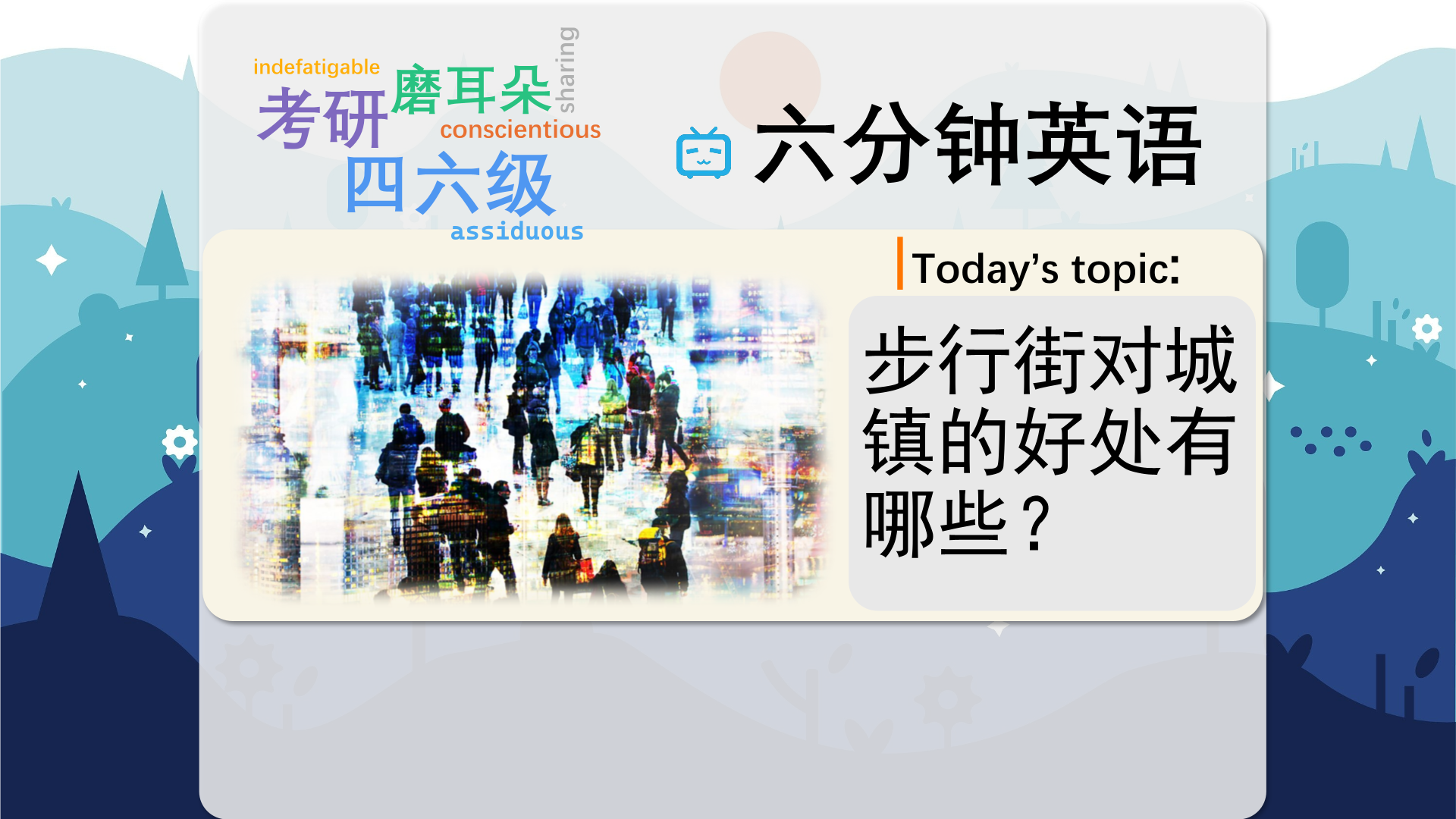
【英文脚本】
Rob
Hello, I’m Rob, and welcome to 6 Minute English, where today we’re chatting about a pedestrian topic and six items of related vocabulary.
Neil
Hello, I’m Neil. A pedestrian is someone who walks around rather than travelling by car or bus. But in Rob’s sentence he used the adjective, and in this context it means dull or uninteresting!
Rob
And of course I was making a pun, Neil. Because of course the show is going to be extremely interesting! It’sabout safety on the streets, and whether pedestrianisation is a good thing or not.
Neil
Pedestrianisation means changing a street into an area that can only be used by pedestrians.
Rob
Well, it sounds like a good idea, no traffic, less noise and air pollution. And no chance of getting knocked down by a car or a bus!
Neil
There are plans to pedestrianise Oxford Street, which is one of the busiest shopping streets in London.
Rob
That’s right. The Mayor of London wants to tackle, or make an effort to deal with, air pollution in this very busy spot, where the amount of traffic is definitely a problem! In fact, can you tell me, Neil, what’s the average speed of a bus travelling along Oxford Street? Is it: a) 4.6 miles per hour, b) 14.6 miles per hour or c) 46 miles per hour?
Neil
And I think it’s 14.6 miles per hour, a) sounds too slow and c) sounds too fast!
Rob
OK, we’ll find out the answer later on. The problem is, the traffic doesn’t just disappear. You ban it from one area, and it gets rerouted somewhere else.
Neil
Ban means to say officially that something can’t be done. And reroute means to change the direction you’re travelling in, in order to reach a particular destination. That’s true, Rob. It must be a big headache for city planners.
Rob
Well, let’s listen now to Joe Urvin, Chief Executive of Living Streets. He’s going to talk some more about why traffic is causing problems in our towns and cities.
Joe Urvin, Chief Executive of Living Streets
In 1970 we had 20 million cars in this country. Now we have over 30 million cars in such a short period. So that creates three big problems. One is space, because we’ve still got the same street structures in our towns and cities, causing congestion. It causes pollution, which people are concerned about more and more. And actually, it’s kind of engineering walking out of our lives. So we’re actually not getting enough exercise, which is a cause of a health crisis. Smart cities are looking at pedestrianisation, in Glasgow, in Birmingham, in London for example, Manchester, as a way of not only making their places, cities better and more attractive, actually, building their local economy.
Neil
So Neil Urvin identifies three problems, the first is that our city streets have stayed the same while the number of cars on the roads has increased dramatically.
Rob
That’s right, and this has led to congestion on our roads. Congestion means too much traffic, making it hard to move.
Neil
The second problem is pollution, which we mentioned earlier.
Rob
Pollution is damage to the environment caused by releasing waste substances such as carbon dioxide into the air.
Neil
And the third problem is that by travelling around on buses or in our cars we aren’t getting enough exercise. And we all know that’s a bad thing! Would pedestrianisation engineer walking back into our lives do you think?
Rob
I’m not sure, Neil. It would be great if we could go shopping or walk to work without breathing in fumes or worrying about getting knocked down by a car. But banning all motorised traffic from town centres might make life difficult for people to get around.
Neil
Well, I’m not a town planner, and I don’t have the answers. But I would like to know if I got the answer right to the question you asked me earlier!
Rob
OK, well I asked you: What’s the average speed of a bus travelling along Oxford Street? Is it… a) 4.6mph, b) 14.6mph or c) 46mph?
Neil
And I said 14.6mph.
Rob
And that’s not slow enough, Neil, I’m afraid. The answer is actually 4.6mph. And we pedestrians walk at an average speed of 3.1mph apparently!
Neil
Good to know. OK, shall we go over the words we learned today, Rob?
Rob
Sure, the first one is ‘pedestrian’, a person who is walking, usually in an area where there’s traffic. ‘Sorry, you can’t ride your bike here. This path is for pedestrians only.’
Neil
The adjective, ‘This book is full of very pedestrian ideas. I wouldn’t read it if I were you.’
Rob
I’ve crossed it off my list, Neil. Thank you. OK, number two is ‘to tackle’ something, which means to make an effort to deal with a difficult problem. For example, ‘The government isn’t really tackling the problem of air pollution. It needs to do much more.’
Neil
Very true. OK, ‘ban’ means to officially say that something can’t be done. ‘The UK government will ban the sale of diesel and petrol cars from 2040.’
Rob
And number four is ‘reroute’ which means to change the direction you’re travelling in.
Neil
‘The council has rerouted all buses to avoid the town centre.’
Rob
‘Congestion’ is number five, too much traffic, making it difficult to move.
Neil
‘Road congestion always gets better in the summer when a lot of car drivers are on holiday.’
Rob
That’s true, isn’t it? London always seems emptier in July and August.
Neil
Except for all the tourists walking around, congesting the streets!
Rob
Very funny! And finally, number six is ‘pollution’, which is damage to the environment caused by releasing waste substances such as carbon dioxide into the air, or plastic into the sea.
Neil
‘You can help reduce air pollution by walking to work every day instead of driving.’
Rob
Are you talking to me, Neil? I always walk to work!
Neil
I know you do, Rob, you’re an example to us all!
Rob
OK, that’s all we have time for today.
Neil
But please don’t forget to visit us via our Twitter, Facebook and YouTube pages! Goodbye!
Rob
Bye bye!
【中英文双语脚本】
Rob(罗伯)
Hello, I’m Rob, and welcome to 6 Minute English, where today we’re chatting about a pedestrian topic and six items of related vocabulary.
大家好,我是 罗伯,欢迎来到 6 Minute English,今天我们将在这里讨论一个行人话题和六个相关词汇。
Neil(尼尔)
Hello, I’m Neil. A pedestrian is someone who walks around rather than travelling by car or bus. But in Rob’s sentence he used the adjective, and in this context it means dull or uninteresting!
大家好,我是 Neil。行人是四处走动而不是乘坐汽车或公共汽车的人。但在 罗伯 的句子中,他使用了形容词,在这种情况下,它的意思是沉闷或无趣!
Rob(罗伯)
And of course I was making a pun, Neil. Because of course the show is going to be extremely interesting! It’sabout safety on the streets, and whether pedestrianisation is a good thing or not.
当然,我是在说双关语,Neil。因为这个节目当然会非常有趣!这关乎街道的安全,以及行人专用区是否是一件好事。
Neil(尼尔)
Pedestrianisation means changing a street into an area that can only be used by pedestrians.
行人专用区是指将街道变成仅供行人使用的区域。
Rob(罗伯)
Well, it sounds like a good idea, no traffic, less noise and air pollution. And no chance of getting knocked down by a car or a bus!
嗯,这听起来是个好主意,没有交通,减少噪音和空气污染。而且没有机会被汽车或公共汽车撞倒!
Neil(尼尔)
There are plans to pedestrianise Oxford Street, which is one of the busiest shopping streets in London.
牛津街 (Oxford Street) 是伦敦最繁忙的购物街之一,市政府计划将牛津街 (Oxford Street) 设为步行街。
Rob(罗伯)
That’s right. The Mayor of London wants to tackle, or make an effort to deal with, air pollution in this very busy spot, where the amount of traffic is definitely a problem! In fact, can you tell me, Neil, what’s the average speed of a bus travelling along Oxford Street? Is it: a) 4.6 miles per hour, b) 14.6 miles per hour or c) 46 miles per hour?
没错。伦敦市长希望解决或努力处理这个非常繁忙的地方的空气污染,那里的交通量绝对是一个问题!事实上,Neil,您能告诉我,沿着 Oxford Street 行驶的公共汽车的平均速度是多少吗?是:a) 每小时 4.6 英里,b) 每小时 14.6 英里还是 c) 每小时 46 英里?
Neil(尼尔)
And I think it’s 14.6 miles per hour, a) sounds too slow and c) sounds too fast!
我认为它是每小时 14.6 英里,a) 听起来太慢了,c) 听起来太快了!
Rob(罗伯)
OK, we’ll find out the answer later on. The problem is, the traffic doesn’t just disappear. You ban it from one area, and it gets rerouted somewhere else.
好的,我们稍后会找出答案。问题是,流量不会消失。你从一个区域禁止它,然后它就会被重定向到另一个区域。
Neil(尼尔)
Ban means to say officially that something can’t be done. And reroute means to change the direction you’re travelling in, in order to reach a particular destination. That’s true, Rob. It must be a big headache for city planners.
Ban 的意思是正式地说某件事不能做。reroute 的意思是改变你的行驶方向,以便到达一个特定的目的地。这是真的,罗伯。对于城市规划者来说,这一定是一个令人头疼的问题。
Rob(罗伯)
Well, let’s listen now to Joe Urvin, Chief Executive of Living Streets. He’s going to talk some more about why traffic is causing problems in our towns and cities.
那么,现在让我们听听 Living Streets 的首席执行官 Joe Urvin 的演讲。他将更多地讨论为什么交通会给我们的城镇带来问题。
Joe Urvin, Chief Executive of Living Streets(JoeUrvin,LivingStreets首席执行官)
In 1970 we had 20 million cars in this country. Now we have over 30 million cars in such a short period. So that creates three big problems. One is space, because we’ve still got the same street structures in our towns and cities, causing congestion. It causes pollution, which people are concerned about more and more. And actually, it’s kind of engineering walking out of our lives. So we’re actually not getting enough exercise, which is a cause of a health crisis. Smart cities are looking at pedestrianisation, in Glasgow, in Birmingham, in London for example, Manchester, as a way of not only making their places, cities better and more attractive, actually, building their local economy.
1970 年,我们这个国家有 2000 万辆汽车。现在,我们在如此短的时间内拥有超过 3000 万辆汽车。所以这会产生三个大问题。一个是空间,因为我们的城镇和城市仍然有相同的街道结构,导致拥堵。它会导致污染,人们越来越关注这种污染。实际上,这是一种从我们的生活中走出来的工程学。所以我们实际上没有得到足够的锻炼,这是健康危机的一个原因。在格拉斯哥、伯明翰、伦敦、曼彻斯特等地,智慧城市正在考虑步行化,这不仅是为了让地方、城市变得更好、更有吸引力,实际上是为了建设当地经济。
Neil(尼尔)
So Neil Urvin identifies three problems, the first is that our city streets have stayed the same while the number of cars on the roads has increased dramatically.
因此,Neil Urvin 指出了三个问题,首先是我们的城市街道保持不变,而道路上的汽车数量却急剧增加。
Rob(罗伯)
That’s right, and this has led to congestion on our roads. Congestion means too much traffic, making it hard to move.
没错,这导致了我们的道路拥堵。拥堵意味着交通拥堵,难以移动。
Neil(尼尔)
The second problem is pollution, which we mentioned earlier.
第二个问题是污染,我们前面提到过。
Rob(罗伯)
Pollution is damage to the environment caused by releasing waste substances such as carbon dioxide into the air.
污染是由于将二氧化碳等废物释放到空气中而对环境造成的破坏。
Neil(尼尔)
And the third problem is that by travelling around on buses or in our cars we aren’t getting enough exercise. And we all know that’s a bad thing! Would pedestrianisation engineer walking back into our lives do you think?
第三个问题是,乘坐公共汽车或汽车四处旅行,我们没有得到足够的锻炼。我们都知道这是一件坏事!你认为行人专用工程师会重新走进我们的生活吗?
Rob(罗伯)
I’m not sure, Neil. It would be great if we could go shopping or walk to work without breathing in fumes or worrying about getting knocked down by a car. But banning all motorised traffic from town centres might make life difficult for people to get around.
我不确定,尼尔。如果我们可以去购物或步行上班,而不用吸入烟雾或担心被汽车撞倒,那就太好了。但是,禁止所有来自市中心的机动车交通可能会使人们的生活变得困难。
Neil(尼尔)
Well, I’m not a town planner, and I don’t have the answers. But I would like to know if I got the answer right to the question you asked me earlier!
好吧,我不是城市规划师,我没有答案。但我想知道我是否正确回答了您之前问我的问题!
Rob(罗伯)
OK, well I asked you: What’s the average speed of a bus travelling along Oxford Street? Is it… a) 4.6mph, b) 14.6mph or c) 46mph?
好的,我问你:沿着牛津街行驶的公共汽车的平均速度是多少?是吗。。。a) 4.6 英里/小时,b) 14.6 英里/小时还是 c) 46 英里/小时?
Neil(尼尔)
And I said 14.6mph.
我说的是 14.6 英里/小时。
Rob(罗伯)
And that’s not slow enough, Neil, I’m afraid. The answer is actually 4.6mph. And we pedestrians walk at an average speed of 3.1mph apparently!
这还不够慢,尼尔,恐怕。答案实际上是 4.6 英里/小时。而我们行人显然以 3.1 英里/小时的平均速度行走!
Neil(尼尔)
Good to know. OK, shall we go over the words we learned today, Rob?
很高兴知道。好,我们来回顾一下我们今天学到的单词吧,罗伯?
Rob(罗伯)
Sure, the first one is ‘pedestrian’, a person who is walking, usually in an area where there’s traffic. ‘Sorry, you can’t ride your bike here. This path is for pedestrians only.’
当然,第一个是“行人”,即正在行走的人,通常在有交通的区域。“对不起,你不能在这里骑自行车。这条路仅供行人使用。
Neil(尼尔)
The adjective, ‘This book is full of very pedestrian ideas. I wouldn’t read it if I were you.’
形容词,“这本书充满了非常平淡无奇的想法。如果我是你,我不会读它。
Rob(罗伯)
I’ve crossed it off my list, Neil. Thank you. OK, number two is ‘to tackle’ something, which means to make an effort to deal with a difficult problem. For example, ‘The government isn’t really tackling the problem of air pollution. It needs to do much more.’
我已经把它从我的清单上划掉了,尼尔。谢谢。好的,第二点是 “解决” 某事,这意味着努力处理一个困难的问题。例如,“政府并没有真正解决空气污染问题。它需要做更多的事情。
Neil(尼尔)
Very true. OK, ‘ban’ means to officially say that something can’t be done. ‘The UK government will ban the sale of diesel and petrol cars from 2040.’
千真万确。好吧,“ban”的意思是正式表示某事不能做。“英国政府将从 2040 年起禁止销售柴油和汽油汽车。”
Rob(罗伯)
And number four is ‘reroute’ which means to change the direction you’re travelling in.
第四个是“reroute”,意思是改变你行驶的方向。
Neil(尼尔)
‘The council has rerouted all buses to avoid the town centre.’
“市议会已经改变了所有公交车的路线,以避开市中心。”
Rob(罗伯)
‘Congestion’ is number five, too much traffic, making it difficult to move.
“拥堵”是第五个,交通太多,难以移动。
Neil(尼尔)
‘Road congestion always gets better in the summer when a lot of car drivers are on holiday.’
“在夏天,当很多汽车司机都在度假时,道路拥堵总是会变得更好。”
Rob(罗伯)
That’s true, isn’t it? London always seems emptier in July and August.
这是真的,不是吗?伦敦在 7 月和 8 月总是显得空旷。
Neil(尼尔)
Except for all the tourists walking around, congesting the streets!
除了所有四处走动的游客,街道上挤满了人!
Rob(罗伯)
Very funny! And finally, number six is ‘pollution’, which is damage to the environment caused by releasing waste substances such as carbon dioxide into the air, or plastic into the sea.
很有趣!最后,第六个是“污染”,即通过将二氧化碳等废物排放到空气中或将塑料排放到海洋中而对环境造成的破坏。
Neil(尼尔)
‘You can help reduce air pollution by walking to work every day instead of driving.’
“你可以通过每天步行上班而不是开车来帮助减少空气污染。”
Rob(罗伯)
Are you talking to me, Neil? I always walk to work!
你在和我说话吗,尼尔?我总是步行去上班!
Neil(尼尔)
I know you do, Rob, you’re an example to us all!
我知道你喜欢,罗伯,你是我们所有人的榜样!
Rob(罗伯)
OK, that’s all we have time for today.
好了,这就是我们今天的全部时间。
Neil(尼尔)
But please don’t forget to visit us via our Twitter, Facebook and YouTube pages! Goodbye!
但请不要忘记通过我们的 Twitter、Facebook 和 YouTube 页面访问我们!再见!
Rob(罗伯)
Bye bye!
再见!

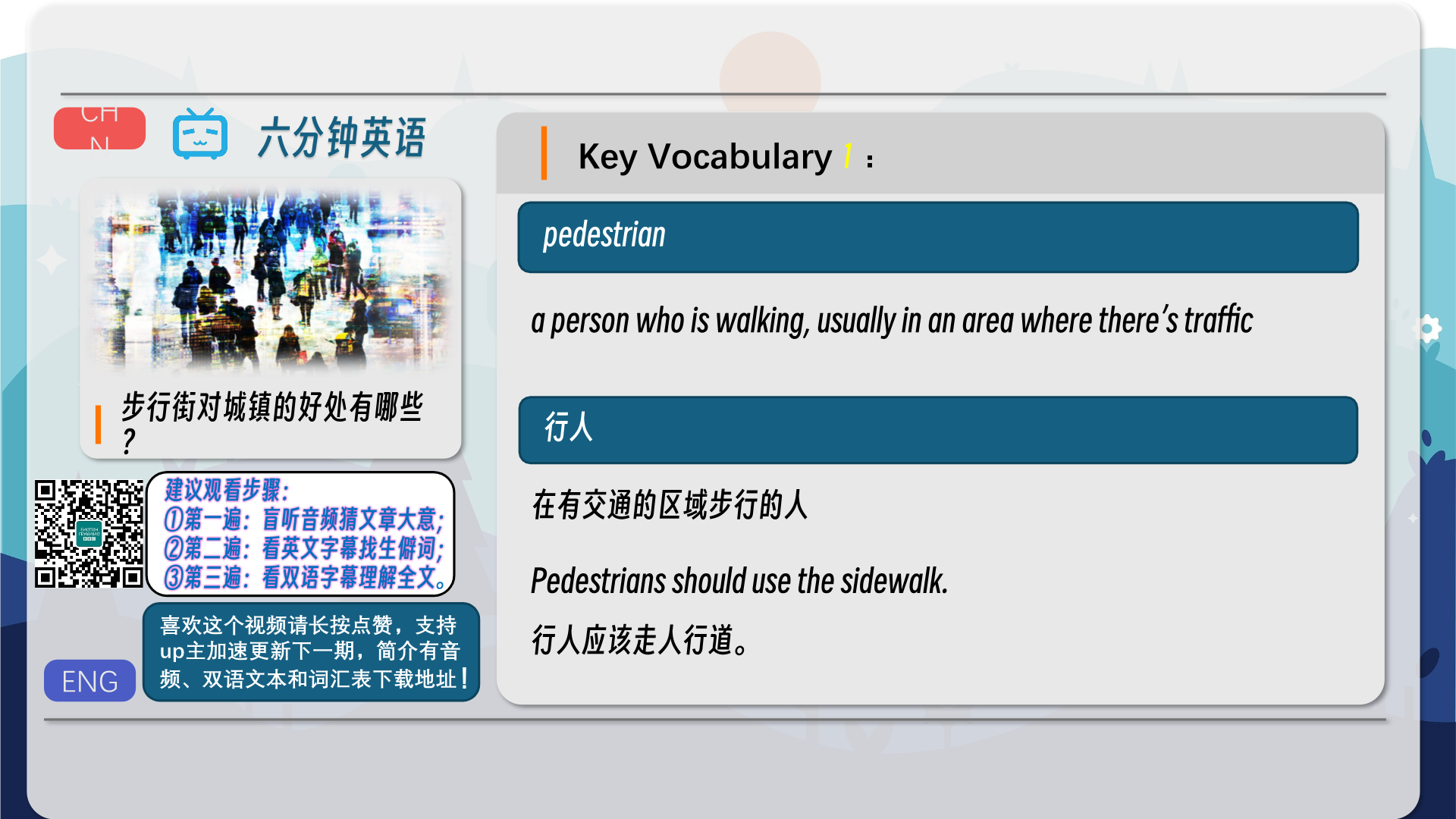
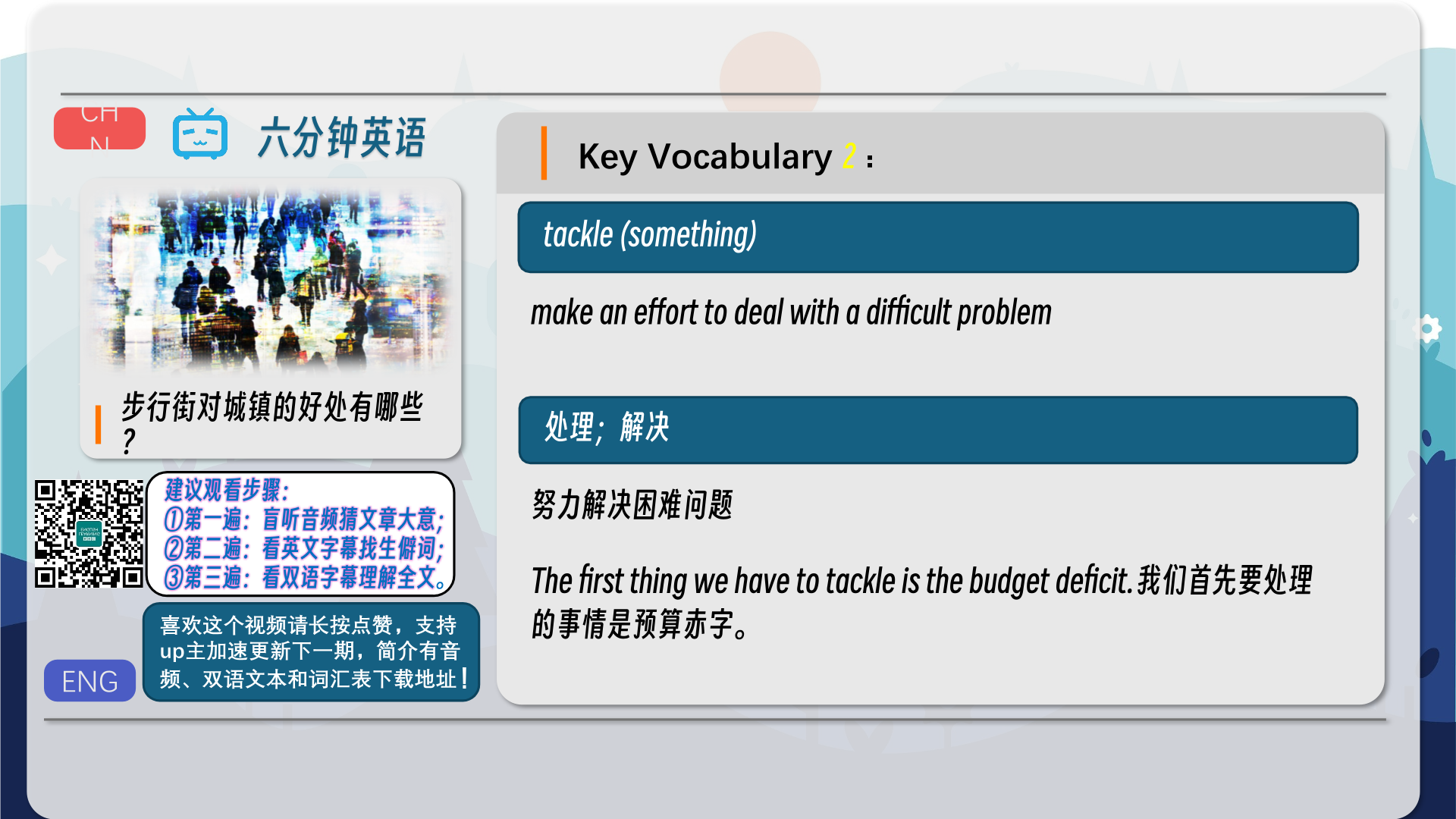
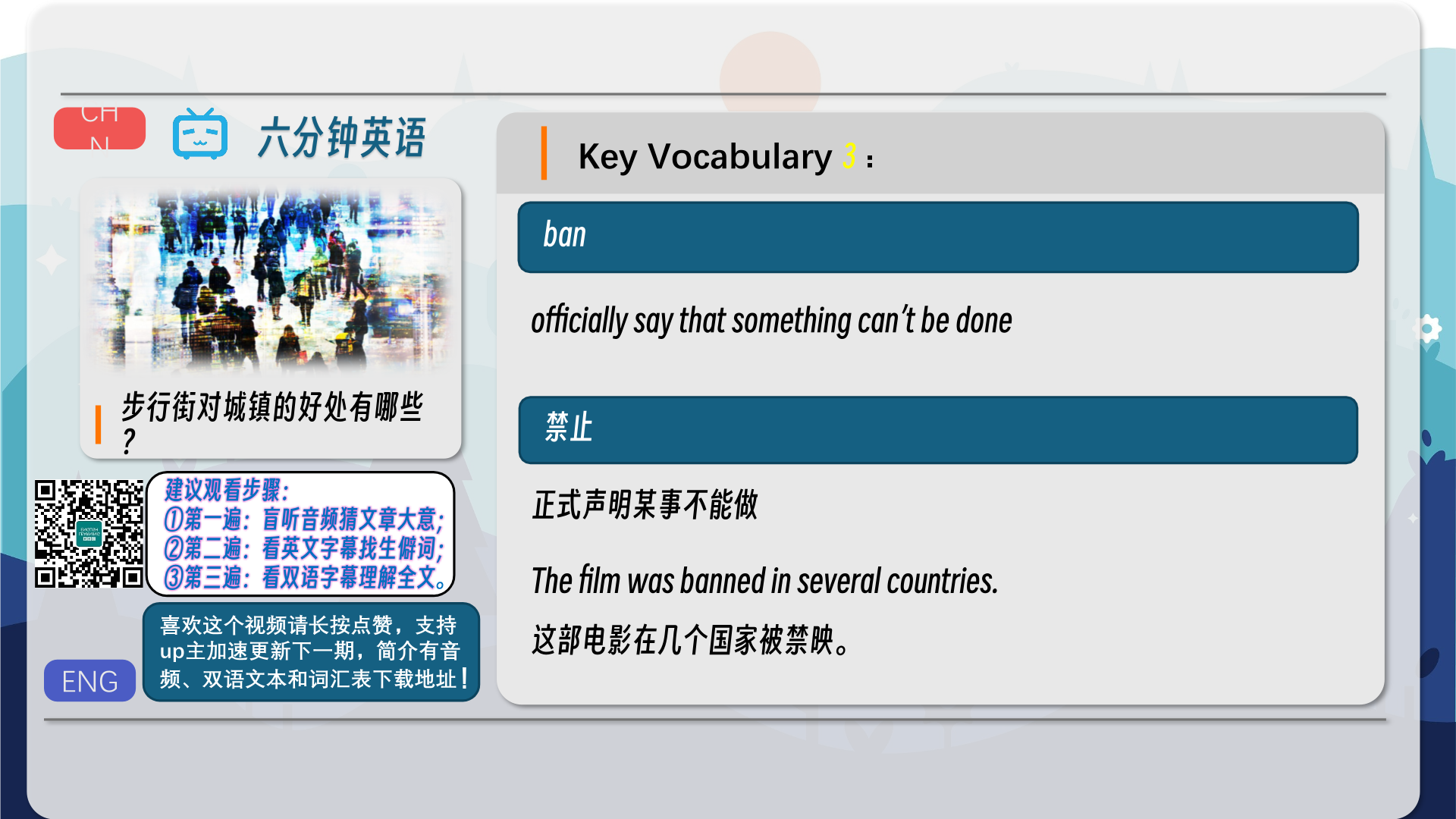
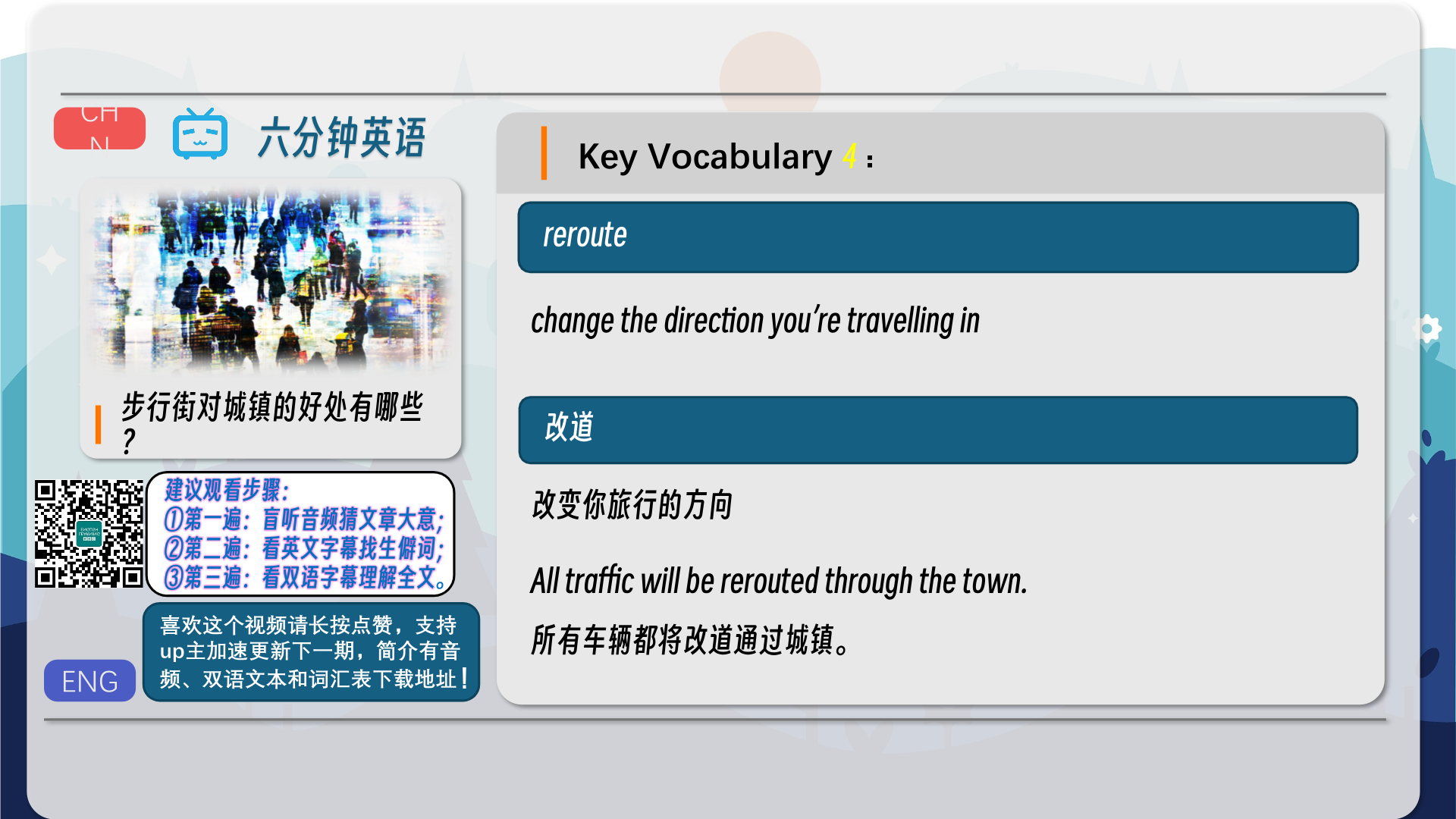

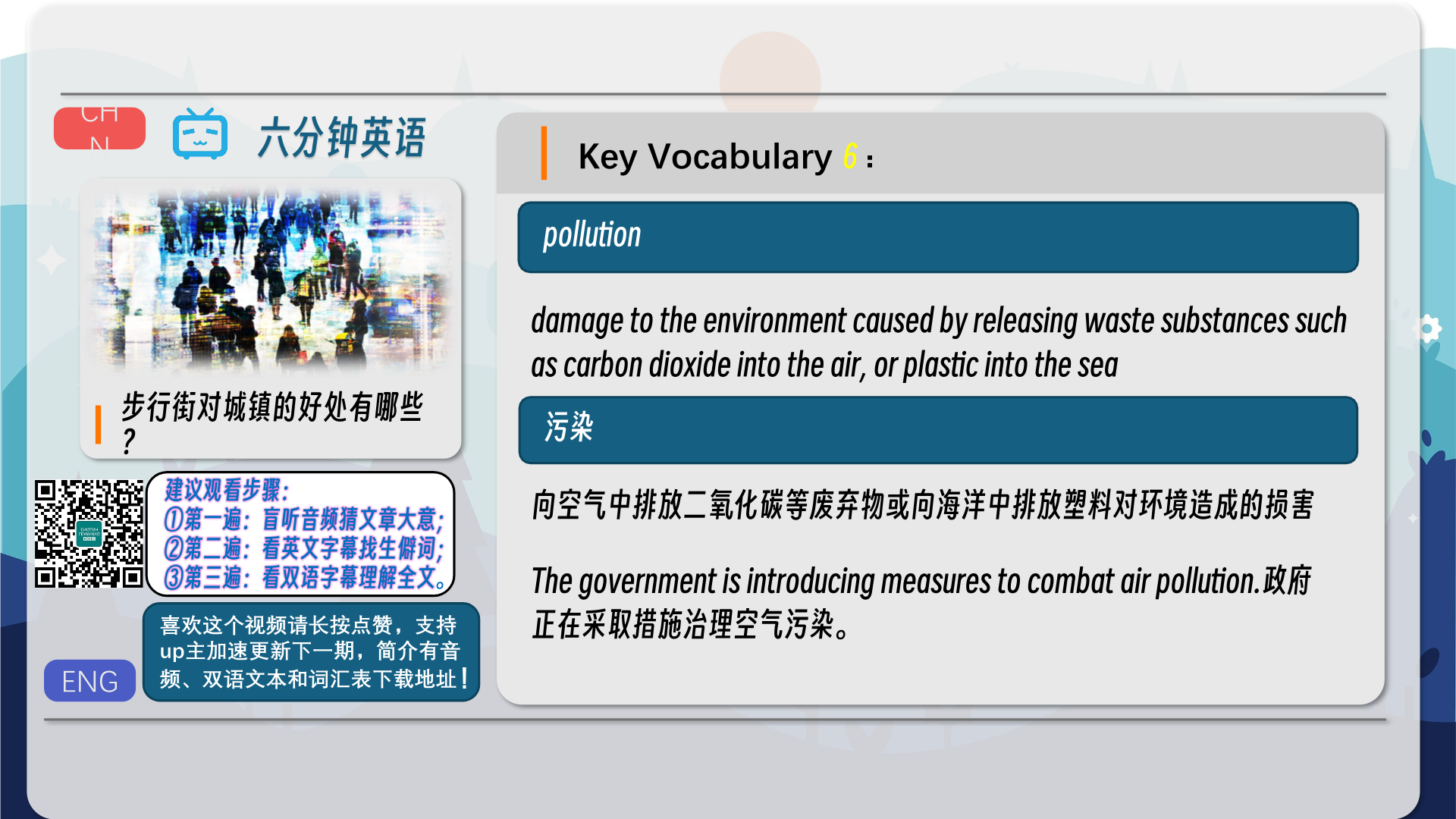
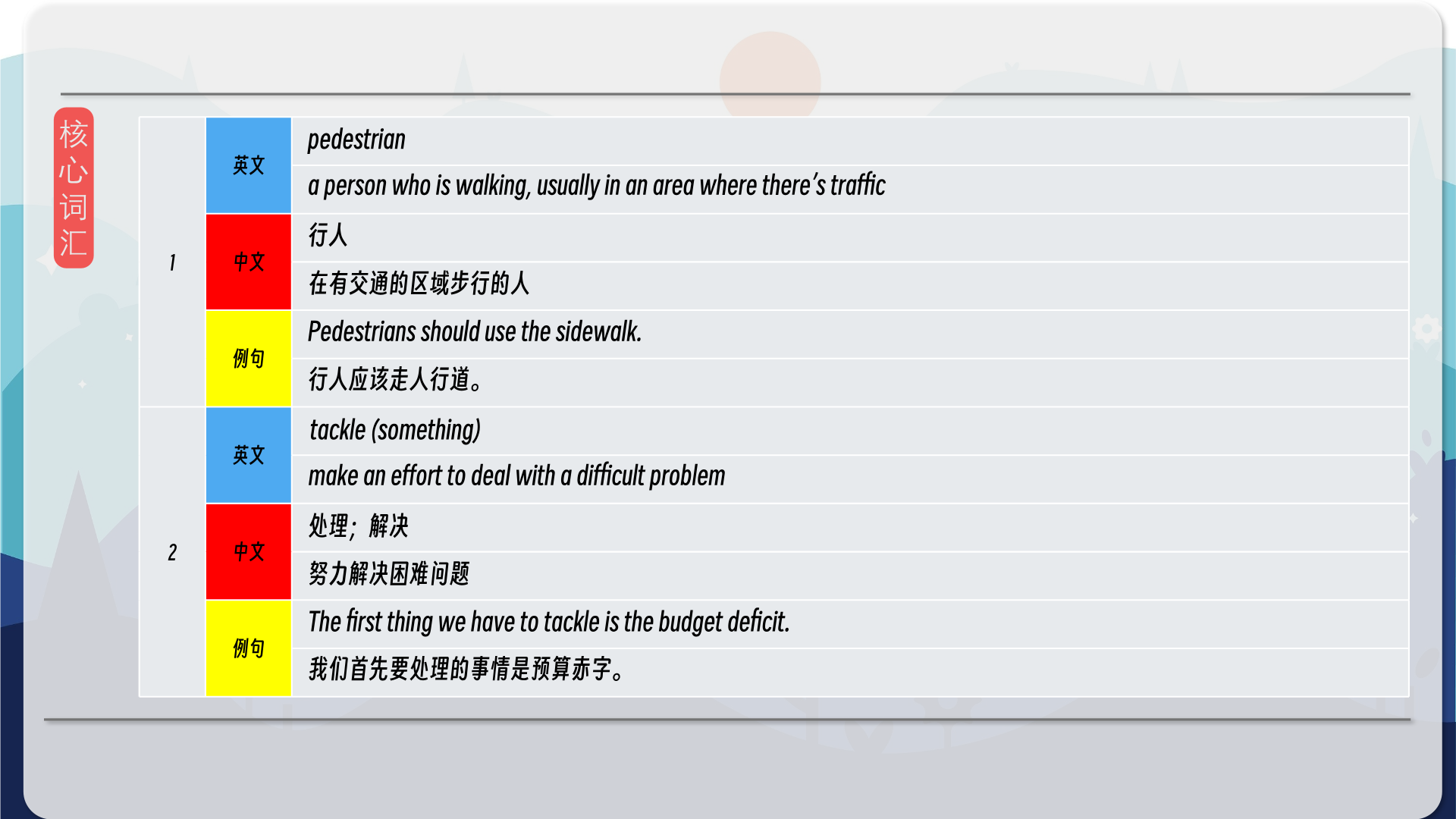
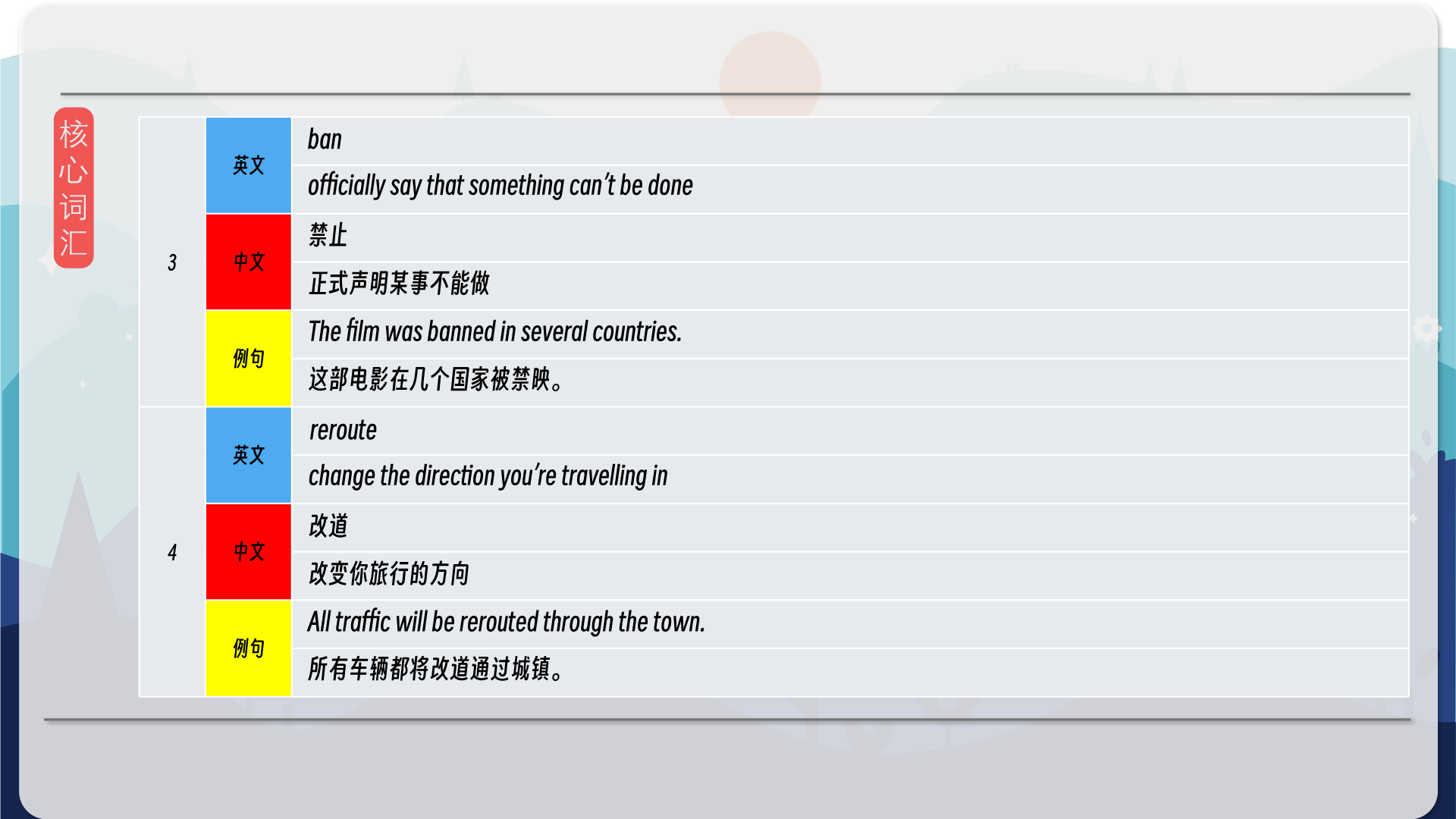
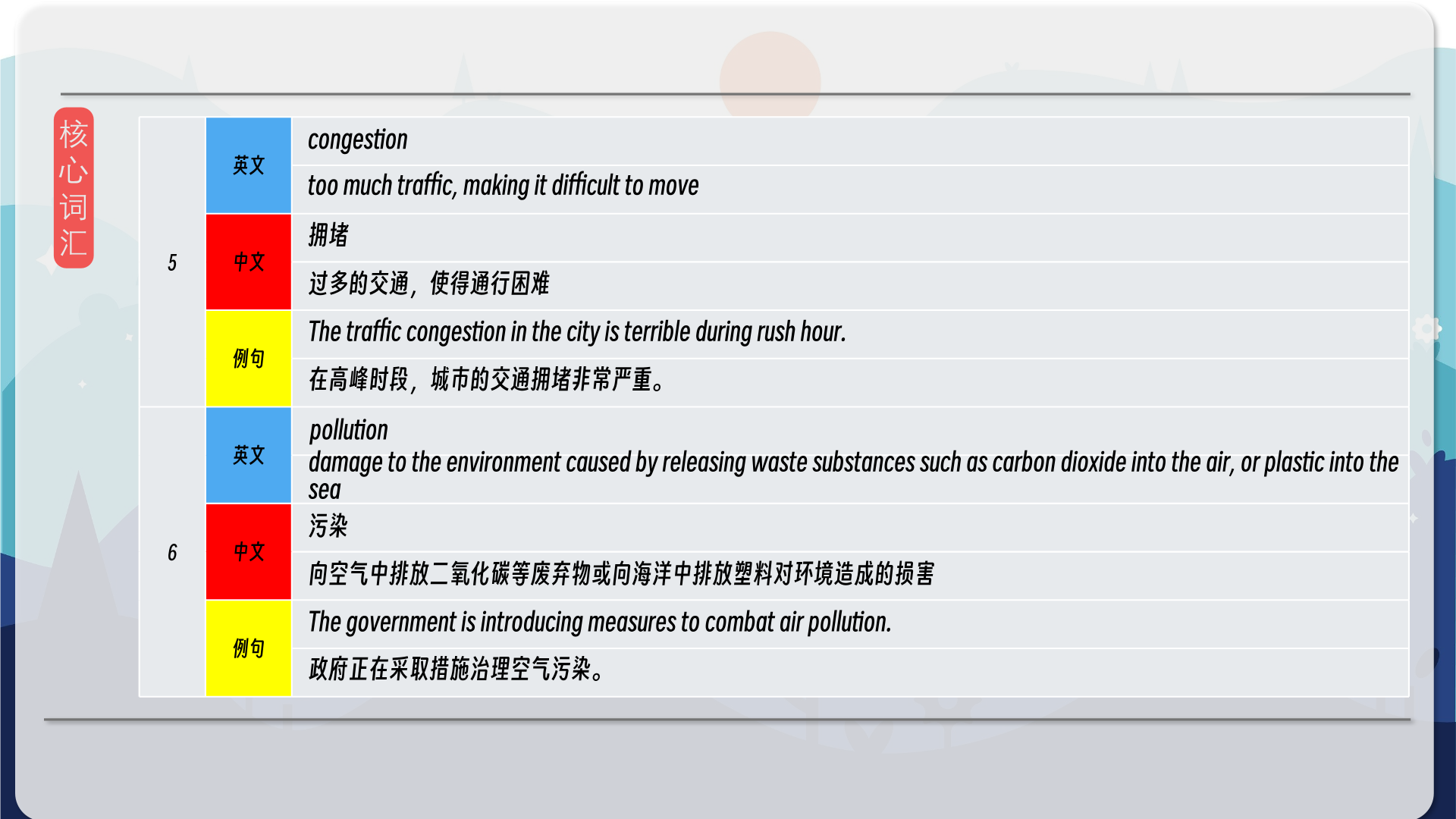
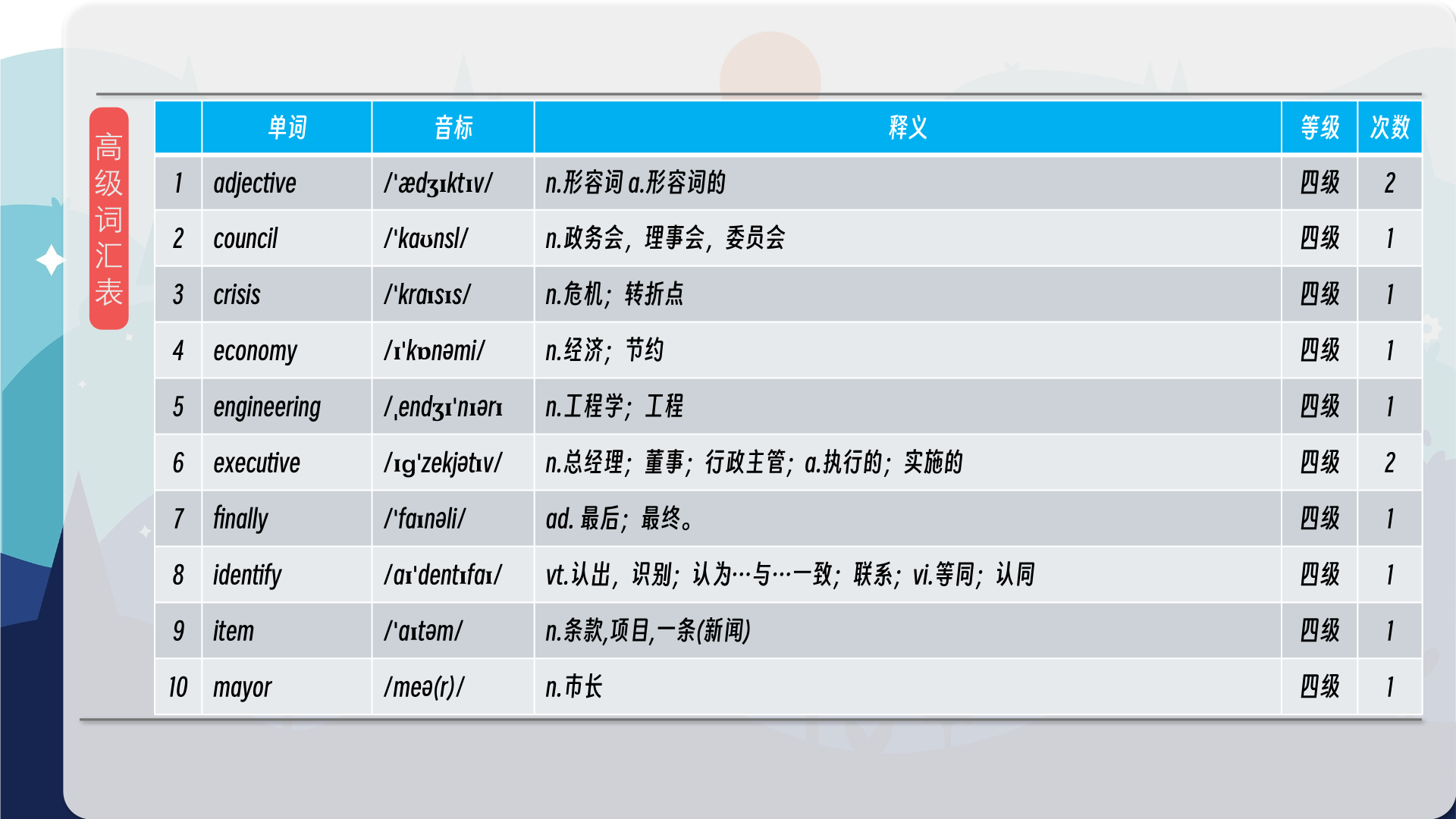
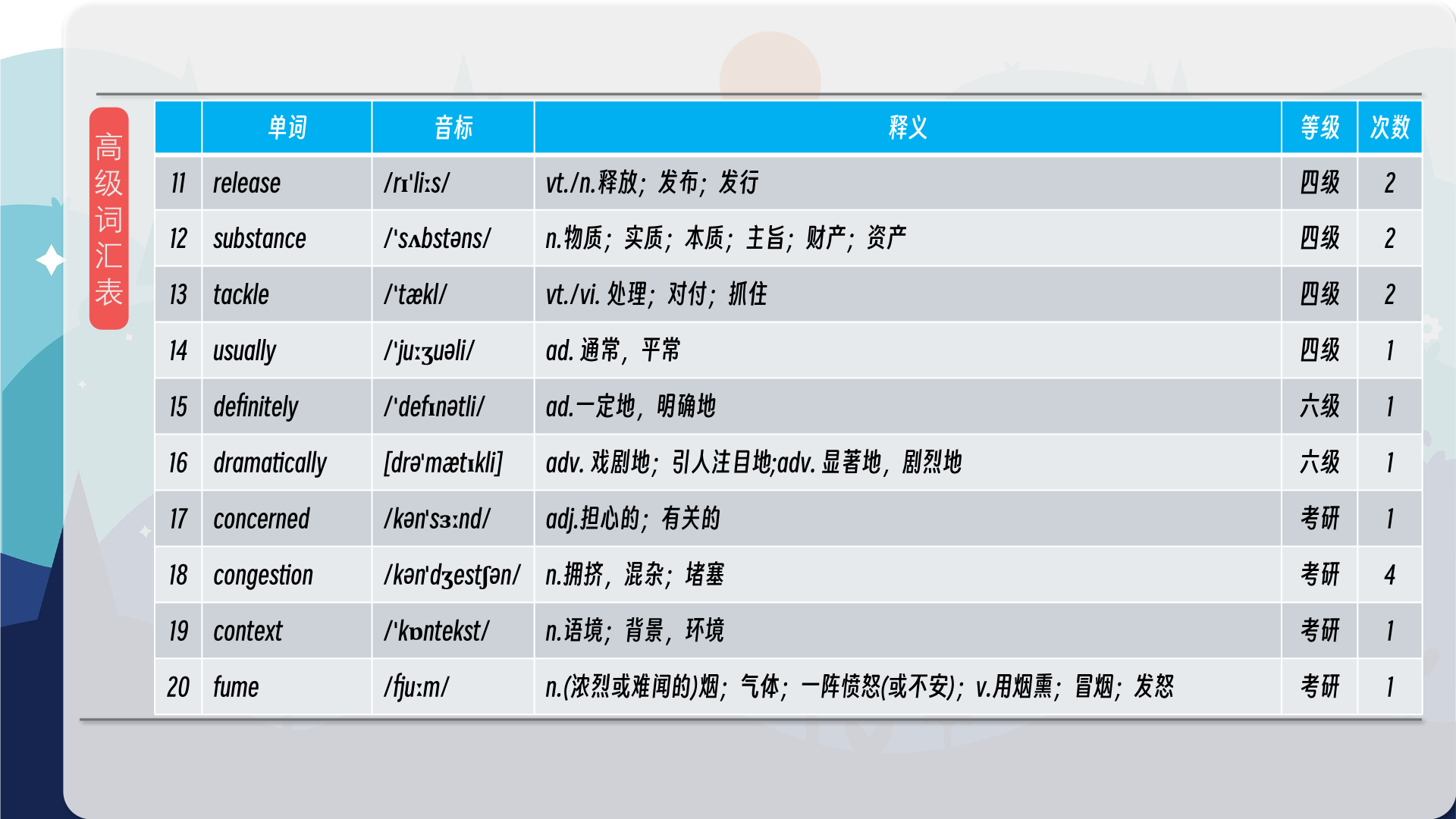
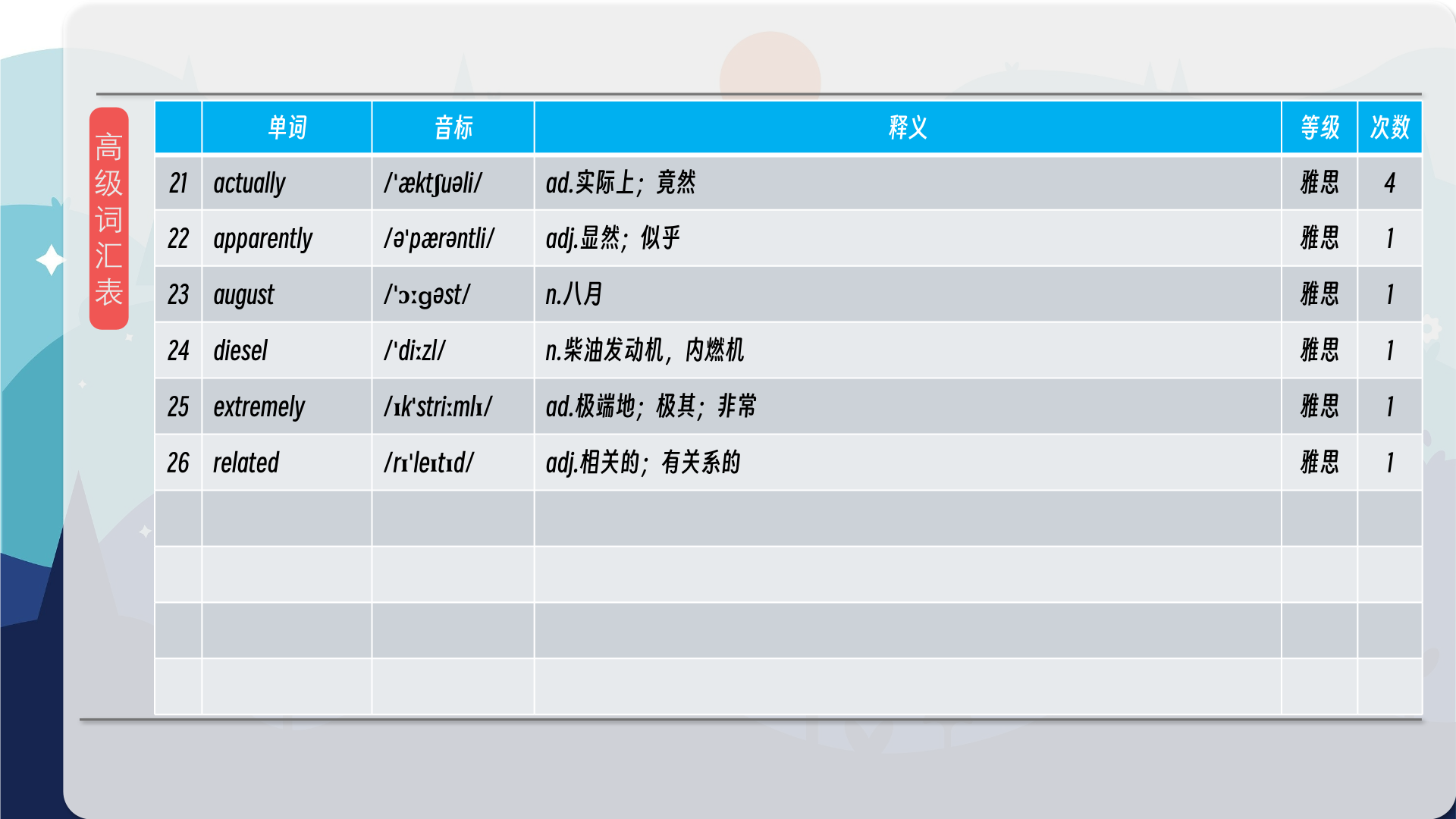

【核心词汇】
pedestrian
a person who is walking, usually in an area where there’s traffic
行人
在有交通的区域步行的人
Pedestrians should use the sidewalk.
行人应该走人行道。
tackle (something)
make an effort to deal with a difficult problem
处理;解决
努力解决困难问题
The first thing we have to tackle is the budget deficit.
我们首先要处理的事情是预算赤字。
ban
officially say that something can’t be done
禁止
正式声明某事不能做
The film was banned in several countries.
这部电影在几个国家被禁映。
reroute
change the direction you’re travelling in
改道
改变你旅行的方向
All traffic will be rerouted through the town.
所有车辆都将改道通过城镇。
congestion
too much traffic, making it difficult to move
拥堵
过多的交通,使得通行困难
The traffic congestion in the city is terrible during rush hour.
在高峰时段,城市的交通拥堵非常严重。
pollution
damage to the environment caused by releasing waste substances such as carbon dioxide into the air, or plastic into the sea
污染
向空气中排放二氧化碳等废弃物或向海洋中排放塑料对环境造成的损害
The government is introducing measures to combat air pollution.
政府正在采取措施治理空气污染。
在公众号里输入6位数字,获取【对话音频、英文文本、中文翻译、核心词汇和高级词汇表】电子档,6位数字【暗号】在文章的最后一张图片,如【220728】,表示22年7月28日这一期。公众号没有的文章说明还没有制作相关资料。年度合集在B站【六分钟英语】工房获取,每年共计300+文档,感谢支持!